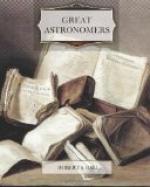We may explain the matter in this way. As the earth is not a sphere, but has protuberant parts at the equator, the attraction of the moon exercises on those protuberant parts a pulling effect which continually changes the direction of the earth’s axis, and consequently the position of the pole must be in a state of incessant fluctuation. The pole to which the earth’s axis points on the sky is, therefore, slowly changing. At present it happens to lie near the Pole Star, but it will not always remain there. It describes a circle around the pole of the Ecliptic, requiring about 25,000 years for a complete circuit. In the course of its progress the pole will gradually pass now near one star and now near another, so that many stars will in the lapse of ages discharge the various functions which the present Pole Star does for us. In about 12,000 years, for instance, the pole will have come near the bright star, Vega. This movement of the pole had been known for ages. But what Bradley discovered was that the pole, instead of describing an uniform movement as had been previously supposed, followed a sinuous course now on one side and now on the other of its mean place. This he traced to the fluctuations of the moon’s orbit, which undergoes a continuous change in a period of nineteen years. Thus the efficiency with which the moon acts on the protuberant mass of the earth varies, and thus the pole is caused to oscillate.
This subtle discovery, if perhaps in some ways less impressive than Bradley’s earlier achievements of the detection of the aberration of light, is regarded by astronomers as testifying even in a higher degree to his astonishing care and skill as an observer, and justly entitles him to a unique place among the astronomers whose discoveries have been effected by consummate practical skill in the use of astronomical instruments.
Of Bradley’s private or domestic life there is but little to tell. In 1744, soon after he became Astronomer Royal, he married a daughter of Samuel Peach, of Chalford, in Gloucestershire. There was but one child, a daughter, who became the wife of her cousin, Rev. Samuel Peach, rector of Compton, Beauchamp, in Berkshire.
Bradley’s last two years of life were clouded by a melancholy depression of spirits, due to an apprehension that he should survive his rational faculties. It seems, however, that the ill he dreaded never came upon him, for he retained his mental powers to the close. He died on 13th July, 1762, aged seventy, and was buried at Michinghamton.
WILLIAM HERSCHEL.
William Herschel, one of the greatest astronomers that has ever lived, was born at Hanover, on the 15th November, 1738. His father, Isaac Herschel, was a man evidently of considerable ability, whose life was devoted to the study and practice of music, by which he earned a somewhat precarious maintenance. He had but few worldly goods to leave to his children, but he more than compensated for this by bequeathing to them a splendid inheritance of genius. Touches of genius were, indeed, liberally scattered among the members of Isaac’s large family, and in the case of his forth child, William, and of a sister several years younger, it was united with that determined perseverance and rigid adherence to principle which enabled genius to fulfil its perfect work.




